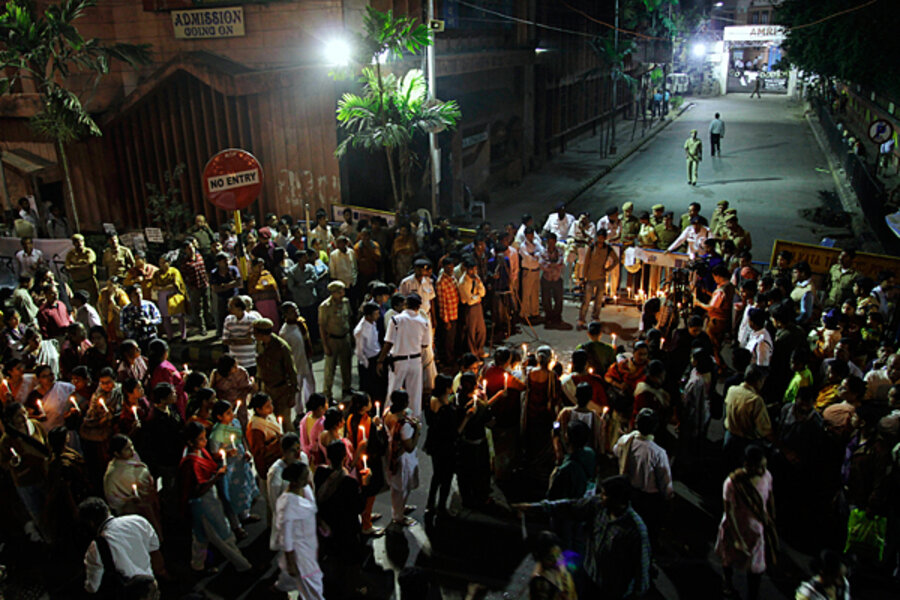Deadly fire prompts review of India's booming hospitals
Loading...
| New Delhi
A hospital fire that killed more than 90 people in India last week is raising concerns about safety procedures in the country's rapidly-expanding hospital system.
Friday's fire swept through AMRI, a 180-bed, state-of-the-art facility with a reputation for being one of the best hospitals in eastern India. But safety was an afterthought. According to local newspapers there were no exit doors or evacuation plan, the windows were sealed, and the local fire department took up to 90 minutes to arrive. Trapped, many of the patients died from asphyxiation.
New hospitals are popping up around India, catering to a growing middle class and even foreigners looking for inexpensive, quality care. While India is gaining a good reputation for its medical talent, construction codes and public safety regulations lag behind.
“Large numbers of hospitals are coming up in a big way across India,” says Dr. Muzzafer Ahmed, a member of the country's National Disaster Management Authority. “What we need to look into when issuing the licenses for running the hospitals is that building construction has complied to safety building codes and a safety plan is in place in case of fire.”
Though such regulations are standard protocols in the US, in India they are still in their infancy. Dr. Muzzafer says the National Disaster Management Authority, which was created by the government in 2005, is still being developed. At present there is no unified disaster plan for New Delhi, a megacity with over 20 million people. Nor is there a national law regulating fire security.
Dr. Shakti Gupta, the medical superintendent for the All India Institute of Medical Sciences (AIIMS), one of the country’s most prestigious institutions, thinks otherwise. He says the safety requirements at his hospital are being met.
“Leading Indian hospitals have got the fire safety system at par with the best in the globe,” says Dr. Gupta. “Moreover, the legal requirements and the strict building code ensure that the state of fire safety preparedness is always high.”
Enforcing Safety Codes
But according to a recent article in the Hindustan Times, an Indian daily, AIIMS is one of three major hospitals in the capital that does not have necessary clearances from the fire department. In addition to lapses in building codes and fire exit strategies, the widespread corruption across the country often makes it possible for code violations to be overlooked.
Following Friday’s blaze, the chief minister of West Bengal, Mamata Banerjee, suspended AMRI’s license, arrested the hospital’s owners, and ordered a judicial investigation into the catastrophe. But, the families of those killed in the fire are still looking for answers. The question remains why the hospital, which had a fire in 2008, was able to pass fire inspection and why the inspectors were not arrested. The families also hold the government, which has a 1.9 percent stake in AMRI, responsible.
Many people in India say the hospital inferno is the perpetuation of a corrupt system, and municipal bodies will have to become more effective if any real safety improvements are going to be made.
Dr. Gupta hopes the tragedy will trigger change at a national policy level.
“I’m sure the licensing authorities will be more cautious and will ensure that systems are in place before granting any license,” says Gupta. “The government should mandate regular fire audits, and it should plan on the opening of more institutes which can train paramedics and medics in fire safety drills.”
There are currently only 50 functioning fire stations in the capital and just 250 ambulances.
Developing Civic Sensibility
Another lesson that has emerged in the days after the fire is the need for greater civic awareness. Ironically, it was not the medical staff that saved many of the patients trapped in the hospital but the patient’s families and citizens from a nearby slum. Security guards hampered their rescue efforts by refusing to let them in the facility. The guards were concerned they would be reprimanded for using outside help to fight the fire and waited about 40 minutes to call the fire department.
“The response time to emergencies is very long,” says Dr. Ahmed. “Anyone who saw a fire raging could have responded. When it comes to any policy that you want to have implemented, you will have to also make sure it takes hold on the civic level, too.”
Get daily or weekly updates from CSMonitor.com delivered to your inbox. Sign up today.





